|
The
Dargaville Museum (New Zealand) presents...
'Accordion Gems' by Kevin Friedrich
...A Master Collection
of Accordions through Time...
Aratapu
Library Purchased - June 2006
Dedication of the Accordion Gems Display - 3 December 2006
Aratapu
Library relocated to Harding Park - January 2007
Grand Opening of New Music Wing at the Dargaville Museum - 21
October 2007 at 1:00 PM
Launching of Accordion Gems Exhibit in Display Cabinets - 29
March 2009
|
|
|
Preserving the
Heritage of the Dargaville Community |
|
The Dargaville Museum secured the
purchase of the historical Aratapu Library, which was the subject
of much attention when it came up for tender after the land
it was situated on was sold. The Aratapu (near Dargaville) Public
Library (1874), a building of great historical value to the
community, was purchased by the Dargaville Museum and subsequently
attached to the existing Museum building. The Library is now
known as the Music Room, and houses the Accordion Gems collection
as well as other items of musical historical importance from
the community.
The community lobbied strongly to keep this building in the
area, and fortunately, the Dargaville Museum was able to offer
the successful bid to purchase it. The building was relocated
to the Museum grounds, attached to the existing Museum, then
restored to its original glory as it was incorporated into the
current Dargaville Museum facilities. The 'Accordion Gems' exhibition
serves as the anchor display in this new Music Room.
The following pages profile the journey of the Aratapu Library
and the establishment of the Music Room and the Accordion Gems
Exhibition.
|
| History
of the Aratapu Library |
|
Extracts from M. Blucher
thesis written in 1973 on the Aratapu Library.
The Library building was originally built in Monk Street but
in July 1893 it followed the movement of the central business
area from there to Heawa Road.
Interview with Mrs. K. H. Fricker, former resident c.
1900 - 1920.
The front room was furnished with a large round table and wrap-round
wooden chairs, which stood in front of the fireplace. Above
it on a chain from a fretwork centerpiece, hung a large kerosene
lamp. The room was used mainly for social purposes and small
meetings.
The actual library occupied the larger rear room and was furnished
with two long tables down the center of the room and wrap-round
chairs. Above the tables hung, equally spaced, two large kerosene
lamps from chains as above. The books were kept in cabinets
placed between the windows on the raised floor down the sides
of the room. This room also had a fireplace above which hung
a portrait of Queen Elizabeth I.
The building always seems to have an unpainted appearance both
inside and out. The rear door was not used - dropped about two
feet to the ground which was swampy. In front of the building
standing taller was the town bell (see Sketch) which was used
in cases of emergency and in times of celebrations.
Interview with Mr. Frank Campbell former resident c 1886
- 1900's.
The library was mainly used by the older retired men of the
town and was always full of pipe smoke and its stench.
Besides the books on its shelves its greatest attraction was
its display of the 'Weekly News" shipped up from Auckland
every week. For many this was the only link with the world outside
the Northern Wairoa. The local paper the 'Wairoa Bell' was also
displayed. The exterior of the buildings was originally painted
as were most of the town's buildings with red ochre. This was
dug locally and mixed amongst other things with raw linseed
oil and mutton fat. The interior was probably coated with Kauri
gum oil.
Construction
The building is constructed in Kauri utilizing framing and sheathing
methods similar to those in use today ie: timber, floor joists,
studs, roof framing. Great care and expense was taken in ornamenting
the facade of the building distinguishing it from other buildings
in the town.
The sides and the rear walls are plain except for the use of
decorative glass in the windows which are all double hung. The
large central panes of glass were plain but with a while lace
pattern over them. These were surrounded by stained glass panels.
The standard of finish inside is also extremely elaborate with
great care being taken in matching, jointing and finishing.
The building is set on timber blocks at present and about 1'
above the ground level, originally around 2' 6''.
|
| Floor
construction |
6''
x 3' sleepers |
| |
6"
x 2" joists at 20" corners |
| |
T
& G flooring |
|
| Wall
Construction |
4"
x 3" studs |
| |
Rusticated
weather boards |
| |
Match
lining inside |
|
| Roof
Construction |
10"
x 1" ridge |
| (Couple
close & Collar) |
7"
x 2" ceiling joists at 20" crs |
| |
6"
x 2" rafters at 20" CRS |
| |
6"
x 1" collar ties every fourth space |
| |
6"
x 1" sarking at 10" center to center |
| |
Corrugated
iron sheathing |
|
| Windows |
Double
Hung |
|
| Doors |
Timber
framed, timber panels beaded in. Internal doors fitted with
spring. |
|
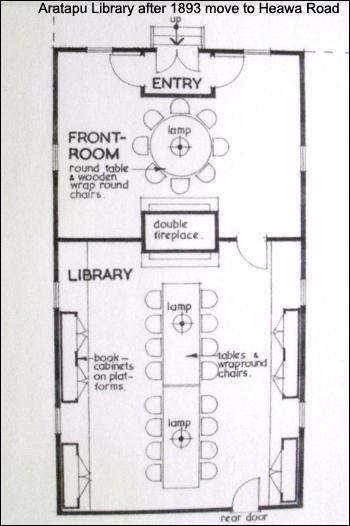 |
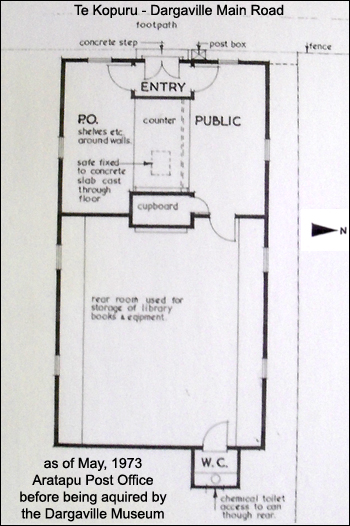 |
|
The
Aratapu Library after
moving to Heawa Road in 1893
|
The Aratapu Library was more recently
used as the Post Office
|
|
| Aratapu
the Town |
|
Aratapu was typical of many towns
in the late 1800's that grew out of the exports of timber, gum
and flax. With the building of the first mill in the district
(1865) Aratapu became the center of commerce with a population
of two thousand people nicknamed "Sawdust Town". Building
followed in quick succession including a large two story boarding
house, a store and scores of dwelling, and soon there were three
good streets, Monk, Bride and Parnell Streets. Mr. Thomas Woollam,
the mill carpenter, built a large number of these buildings
under contract.
The Aratapu Village sections, generally of one acre, were first
opened for settlement in the year 1888 and sold at five pounds.
The settlement which previously had been built on sawdust near
the sawmill in Monk Street, soon extended up Heawa Road towards
what is today, the main Te Kopuru - Dargaville Highway. As the
population increased there was every type of business to meet
the needs of the people and the foreshore was spalled for erosion,
although this did not stop the flooding however. There was a
Hall, Library, two Churches, School, Post Office, Police Station,
Hobson county council offices, Hotel and several boarding-houses.
The Wharf was a thriving hive of activity with ships loading
timber and regular ferry services to Dargaville and Helensville.
Community spirit was high with a band, choral society and plenty
of Church functions. Sport played an important part with several
rugby, tug-of-war and cricket teams. In years to come, there
was also a skating rink and even motion pictures.
With the closing of the Mill in 1909 the once thriving little
town was soon reduced to a village. Several stores remained
to serve those who stayed, as well as the surrounding population
but the closing of the Post Office in 1942 spelt the end. Glamuzina
& Sons operated a mill until the 1970's but most of the
houses have now been removed or demolished.
Today, not much remains of Aratapu but the Hotel on the main
road and the old Hall to remind visitors that this was once
a township of two thousand people full of energy and purpose.
|
|
The Aratapu Library is re-aquired on June 9, 2006 |
|
Ironically, the Aratapu Library
was formally owned by the Dargaville Museum. The museum acquired
the Aratapu Library about 30 years ago and had it moved to the
then museum site in Normanby Street, Dargaville, now the Norfolk
Court Resthome. When
the museum moved to its present site at Harding Park in 1985
the Aratapu Library, deemed surplus to requirements, was
given to the IHC and shifted to a rural training unit for Intellectually
handicapped individuals near the Dargaville racecourse at Awakino
Point. However, the IHC sold that property and the new owner,
Steve Griffiths, then put the library up for tender.
The pending sale sparked calls from the community for the old
building to be kept in the district and the Dargaville Museum
put in a tender which included $20,000 from its reserves, donations
such as $1500 from the Northern Wairoa Lions Club, and a bank
loan. Mr. Griffiths said he received tenders from Whangarei,
Auckland and Te Puke, but he had taken a "sympathetic view''
of the Museum's situation and the prized 1874 Aratapu Library
was returned to its former owner for an undisclosed price.
|
|
|
| Penguins
and Power Lines |
|
On Wednesday, 18th January 2007,
after the roof was removed to allow the building to be moved
safely under the power lines that had been added since the building
was located on this particular site, the relocation took place
in the middle of the night to cause the least amount of disruption,
and went almost without incident.
Almost without incident! The midnight procession had to be halted
enroute, to remove a Penguin that had chosen the middle of the
road next to the Northern Wairoa River (which connects to the
open sea) to make its home for the night. The Penguin was safely
returned to the water, and the move continued!
|
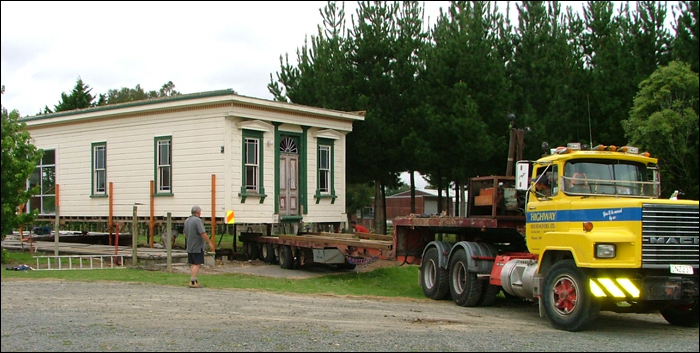 |
|
The
Aratapu Library being loaded onto the removal truck
|
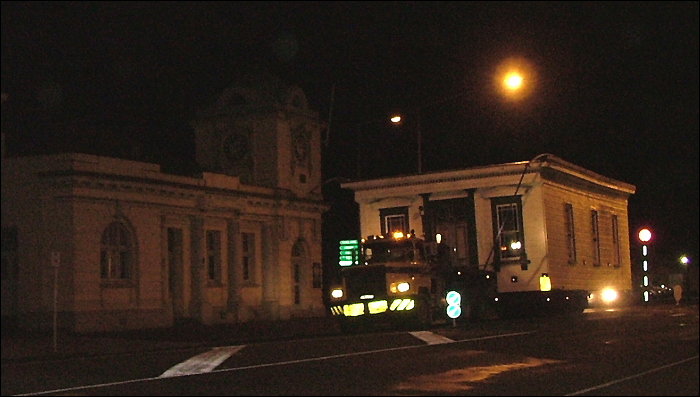 |
|
The
Aratapu Library passing by the Dargaville Post
Office. The only hitch during the trip to the Dargaville
Museum grounds was when the procession came to a halt
when it encountered a friendly Penguin who had made itself
at home on the road. The Penguin was removed and put back
into the water and the move continued!
|
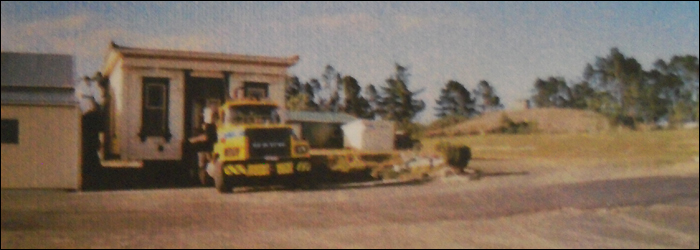 |
|
After
navigating the narrow and windy road up to the top of
Mt. Wesley in Harding Park,
the Library is safely delivered to its new home.
|
|
| Restoring
the Aratapu Library to her former Glory |
Museum volunteers
showered the Library with their community spirit and spent countless
months restoring the Aratapu Library to her former glory, turning
the poor disheveled abandoned building into the spectacular Kauri
gem it once was. You can follow along the progress through this
series of pictures.
|
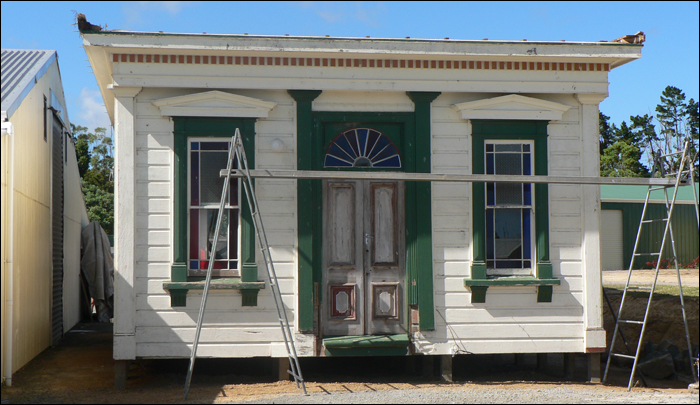 |
|
After
being relocated to the Dargaville Museum grounds, the
work began to restore the building to its former glory.
|
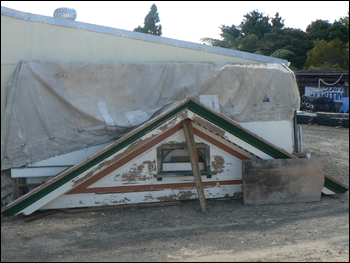 |
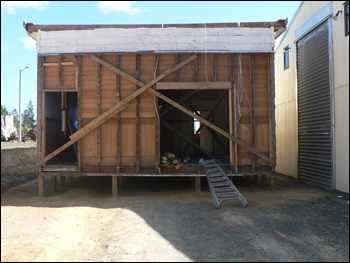 |
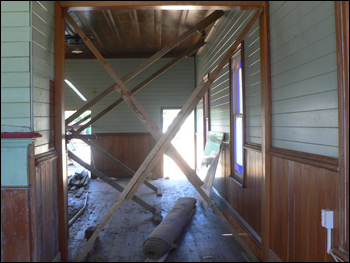 |
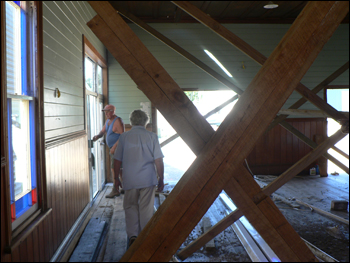 |
 |
 |
|
Museum
Manager Pene McKenzie showing Val Friedrich around the
facility.
|
 |
 |
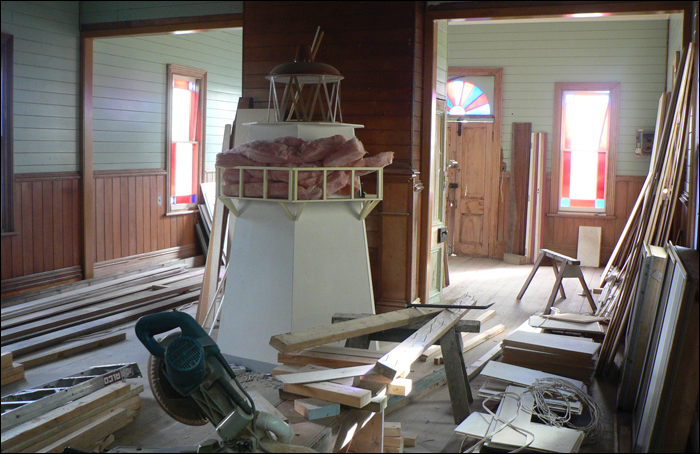 |
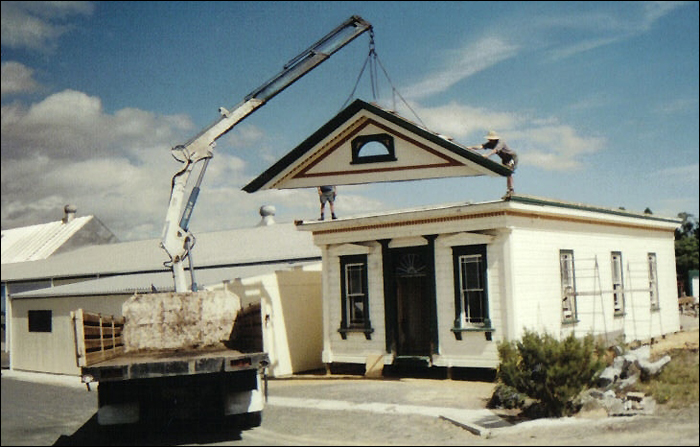 |
|
As work
progressed, the roof was refitted to the Library where
work began restoring the roof section.
|
|
|
 |
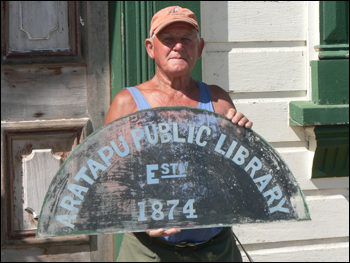 |
|
Above
and below: Ron Halliday (Museum Committee Member) with
the original 1874 Sign from the Library
|
 |
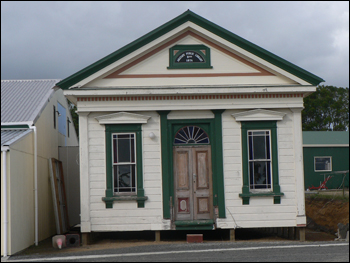 |
 |
|
Margaret
Tier, Graeme Fell, Ted Tier working on the restoration
of the Aratapu Library
|
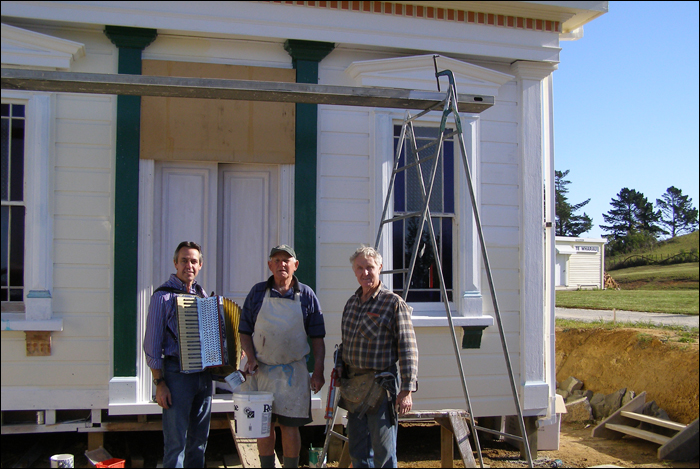 |
|
...a
little musical interlude as Museum staff Ron Halliday
and Ted Teir continue their restoration
|
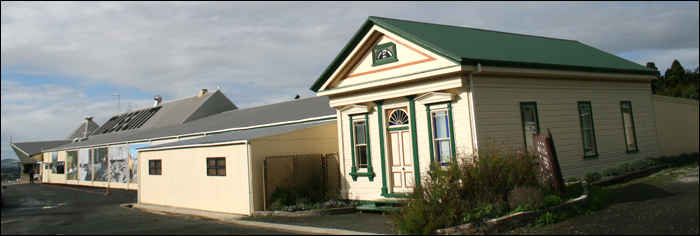 |
|
The
refurbished Library sitting proudly in its new home, attached
to the Dargaville Museum, accessible to visitors, from
the main Museum facility, where the Music Room is attached
to the Collections Hall
|
 |
 |
|
The
Dargaville Museum, situation on Mt. Wesley in Harding
Park, affording magnificent views of the
Dargaville Township and the expanse of the Northern Wairoa
River and the Northern Wairoa Bridge
|
 |
 |
|
Dargaville
is approximately 2 1/2 hours drive north of Auckland,
or 1 hour drive west of Whangarei. From Dargaville, visitors
can proceed north through the magnificent Trounsin Park
and Waipoua Kauri Forests towards the Bay of Islands,
Ninety Mile Beach and Cape Reinga, where the Pacific Ocean
collides with the Tasman Sea.
|
 |
|
Above:
the spectacular view from the Dargaville Museum Entrance
where visitors can see the
Tangihua Mountain Ranges looming over the historic Northern
Wairoa River and the Dargaville Township
|
 |
|
Above:
The Dargaville Museum viewed from the Band Rotunda in
Victoria Street in the center of Dargaville
|
 |
|
Above:
The Northern Wairoa Bridge leading into Dargaville
Below: The volcanic plugs of Maungaraho
(left) and
Tokatoka (right)
|
 |
 |
|
The
Dargaville Museum as viewed from the banks of the mighty
Northern Wairoa River
|
Contact
for the Accordion Gems Exhibition: Kevin Friedrich

|
|
Copyright©
2012 Accordions Worldwide. All rights reserved.
|